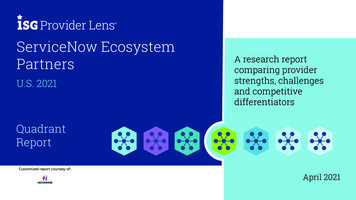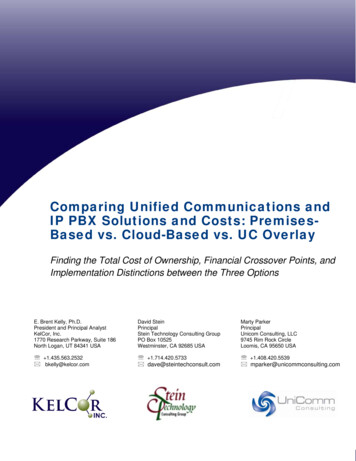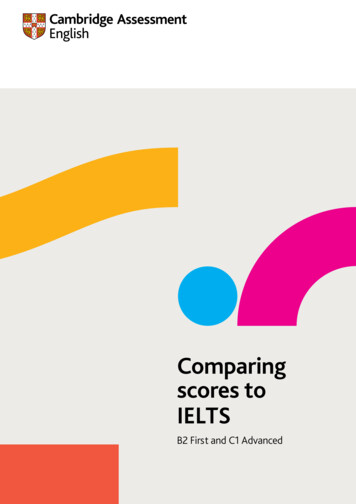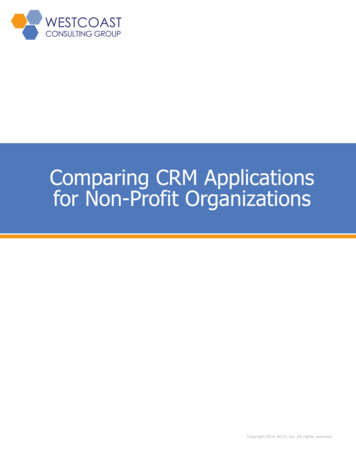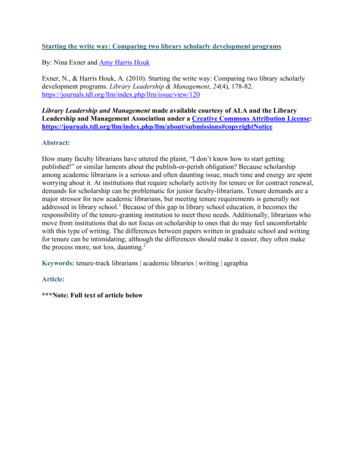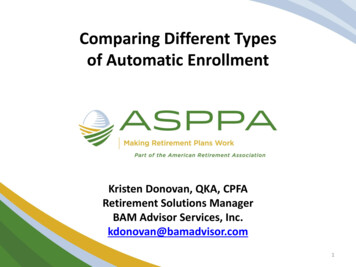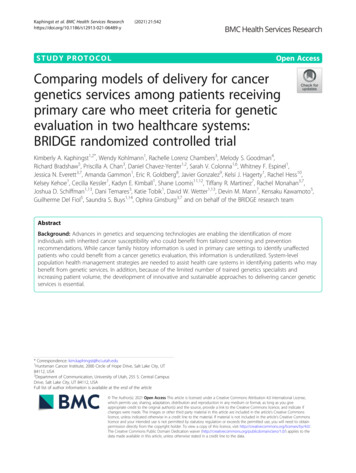
Transcription
Kaphingst et al. BMC Health Services (2021) 21:542STUDY PROTOCOLOpen AccessComparing models of delivery for cancergenetics services among patients receivingprimary care who meet criteria for geneticevaluation in two healthcare systems:BRIDGE randomized controlled trialKimberly A. Kaphingst1,2*, Wendy Kohlmann1, Rachelle Lorenz Chambers3, Melody S. Goodman4,Richard Bradshaw5, Priscilla A. Chan3, Daniel Chavez-Yenter1,2, Sarah V. Colonna1,6, Whitney F. Espinel1,Jessica N. Everett3,7, Amanda Gammon1, Eric R. Goldberg8, Javier Gonzalez9, Kelsi J. Hagerty1, Rachel Hess10,Kelsey Kehoe1, Cecilia Kessler1, Kadyn E. Kimball1, Shane Loomis11,12, Tiffany R. Martinez7, Rachel Monahan3,7,Joshua D. Schiffman1,13, Dani Temares3, Katie Tobik1, David W. Wetter1,13, Devin M. Mann7, Kensaku Kawamoto5,Guilherme Del Fiol5, Saundra S. Buys1,14, Ophira Ginsburg3,7 and on behalf of the BRIDGE research teamAbstractBackground: Advances in genetics and sequencing technologies are enabling the identification of moreindividuals with inherited cancer susceptibility who could benefit from tailored screening and preventionrecommendations. While cancer family history information is used in primary care settings to identify unaffectedpatients who could benefit from a cancer genetics evaluation, this information is underutilized. System-levelpopulation health management strategies are needed to assist health care systems in identifying patients who maybenefit from genetic services. In addition, because of the limited number of trained genetics specialists andincreasing patient volume, the development of innovative and sustainable approaches to delivering cancer geneticservices is essential.* Correspondence: kim.kaphingst@hci.utah.edu1Huntsman Cancer Institute, 2000 Circle of Hope Drive, Salt Lake City, UT84112, USA2Department of Communication, University of Utah, 255 S. Central CampusDrive, Salt Lake City, UT 84112, USAFull list of author information is available at the end of the article The Author(s). 2021 Open Access This article is licensed under a Creative Commons Attribution 4.0 International License,which permits use, sharing, adaptation, distribution and reproduction in any medium or format, as long as you giveappropriate credit to the original author(s) and the source, provide a link to the Creative Commons licence, and indicate ifchanges were made. The images or other third party material in this article are included in the article's Creative Commonslicence, unless indicated otherwise in a credit line to the material. If material is not included in the article's Creative Commonslicence and your intended use is not permitted by statutory regulation or exceeds the permitted use, you will need to obtainpermission directly from the copyright holder. To view a copy of this licence, visit http://creativecommons.org/licenses/by/4.0/.The Creative Commons Public Domain Dedication waiver ) applies to thedata made available in this article, unless otherwise stated in a credit line to the data.
Kaphingst et al. BMC Health Services Research(2021) 21:542Page 2 of 14Methods: We are conducting a randomized controlled trial, entitled Broadening the Reach, Impact, and Delivery ofGenetic Services (BRIDGE), to address these needs. The trial is comparing uptake of genetic counseling, uptake ofgenetic testing, and patient adherence to management recommendations for automated, patient-directed versusenhanced standard of care cancer genetics services delivery models. An algorithm-based system that utilizesstructured cancer family history data available in the electronic health record (EHR) is used to identify unaffectedpatients who receive primary care at the study sites and meet current guidelines for cancer genetic testing. We areenrolling eligible patients at two healthcare systems (University of Utah Health and New York University LangoneHealth) through outreach to a randomly selected sample of 2780 eligible patients in the two sites, with 1:1randomization to the genetic services delivery arms within sites. Study outcomes are assessed through geneticsclinic records, EHR, and two follow-up questionnaires at 4 weeks and 12 months after last genetic counselingcontactpre-test genetic counseling.Discussion: BRIDGE is being conducted in two healthcare systems with different clinical structures and patientpopulations. Innovative aspects of the trial include a randomized comparison of a chatbot-based genetic servicesdelivery model to standard of care, as well as identification of at-risk individuals through a sustainable EHR-basedsystem. The findings from the BRIDGE trial will advance the state of the science in identification of unaffectedpatients with inherited cancer susceptibility and delivery of genetic services to those patients.Trial registration: BRIDGE is registered as NCT03985852. The trial was registered on June 6, 2019 at clinicaltrials.gov.Keywords: Genetic services, Primary care, Health technology, Population health managementBackgroundHereditary cancer syndromes affect patients’ risks ofmany common, adult-onset cancers [1–5]. Pathogenicvariants (i.e., variants that increase cancer risk; PVs) incancer predisposition genes can be identified in thegermline of 7% of breast, 11–15% of ovarian [2, 6–8],10% of colorectal [3, 9, 10], 4–11% of pancreas [11], and12% of advanced prostate cancers unselected for age,family history, or ethnicity [12, 13]. Prior evidence supports individualizing cancer screening and preventionbased on cancer risk for unaffected individuals without apersonal history of cancer [14–19].Advances in genetics and sequencing technologies areallowing the identification of more individuals with aninherited cancer susceptibility who could benefit fromtailored cancer screening and prevention recommendations. A growing number of genes have been associatedwith increased risks for breast, ovarian, colorectal, pancreas, and prostate cancers [7, 10, 11, 13, 20–24]. Use ofmulti-gene panel testing can more than double the rateof detection of PVs compared to testing single genes[25–28], and newer sequencing technologies are alsoexpanding the tumor spectrum associated with particular genes. These factors are leading to a broader range offamily histories being considered as an indication forgenetic testing [29]. All these advances are leading torapidly increasing numbers of unaffected patients whomeet indications for genetic testing and highlight theneed to develop novel ways to identify eligible patientsand then deliver cancer genetics services. Our study, en-titled Broadening the Reach, Impact, and Delivery ofGenetic Services (BRIDGE), is addressing this gap.Identification of unaffected individuals with hereditarycancer syndromesEfforts to identify individuals with inherited cancer susceptibility have generally focused on first testing patientswho have had cancer with subsequent testing of theirunaffected at-risk relatives once a PV is found [30–32].However, this strategy misses families in which there isno living, affected relative to test, and may be an important barrier to accessing genetic services. Studies havebegun to explore the feasibility of screening unaffectedpatients for inherited cancer susceptibility in primarycare settings [33–36]. In these settings, cancer familyhistory information can be used to identify those mostlikely to carry a PV as well as to tailor screening regardless of whether a PV is identified [37–43]. Nationalguidelines recommend testing for unaffected individualswith a significant cancer family history [44], and the Affordable Care Act mandated coverage of genetic testingfor hereditary breast/ovarian cancer for unaffected individuals with appropriate family history [45]. However,family history information is underutilized to stratify risk[46–48], leading to missed opportunities for referral togenetic testing [49]. In one study, 37% of newly diagnosed breast cancer patients found to have PVs had afamily history that warranted genetic testing prior totheir diagnosis [50]. The National Health Interview Survey reported that only 9.5% of unaffected women with a
Kaphingst et al. BMC Health Services Research(2021) 21:542family history of breast and ovarian cancer had discussedgenetic testing with their healthcare provider, and only2.7% had genetic testing [51].Novel strategies are therefore needed to facilitate theuse of family history information to identify unaffectedindividuals who may have inherited cancer susceptibility.Although some family history information is often collected in primary care settings, barriers to collecting orusing this information in clinical practice include limitedvisit time; competing demands; reimbursement criteria;and providers’ training, knowledge and skills [47, 52–56]. Primary care providers (PCPs) may not have specialized knowledge about genetics and genetic conditions orknow who to refer for genetic services [57], and theremay be limited availability of specialists outside of referral centers making the services difficult for many peopleto access, particularly those in rural areas. Many toolsthat are available to facilitate use of family history information in primary care require significant time and resources and were developed independent of workflowstandards in clinics; as a result, widespread implementation of these tools has not occurred [48, 49]. Systemlevel strategies, such as population health management,are needed to assist PCPs in identifying patients whomay benefit from genetic services [58].To address the need for a system-level populationhealth management strategy, our team has developed analgorithm-based system to screen cancer family historyinformation already available in the electronic healthrecord (EHR) [59], and identify unaffected patients whoreceive primary care at the study sites and meet criteriafor genetic evaluation for hereditary breast, ovarian,prostate, pancreas, and/or colorectal cancers [60, 61]. Apilot test conducted with 71 patients receiving primarycare at University of Utah Health (UHealth) who wereidentified with the algorithm showed that the majority(62%) were successfully engaged through outreach fromthe cancer genetics team to consider genetics evaluation[62]. This algorithm forms the basis of a system-wideapproach in the BRIDGE study to identify unaffectedprimary care patients meeting guidelines for geneticevaluation.Models for delivery of cancer genetic servicesOnce unaffected individuals at risk for a hereditary cancer syndrome are identified, genetic services (e.g., geneticcounseling, genetic testing, risk-reduction recommendations) need to be delivered. The number of trained genetic specialists is limited both in capacity and location,and more sustainable, and reimbursable, service deliverymodels are needed to accommodate an increasing patient volume [63–65]. Therefore, the development andtesting of innovative approaches to the delivery of cancergenetic services is essential.Page 3 of 14Prior research has compared different delivery modelsfor cancer genetic services [66]. A number of these studies have evaluated alternative modes of delivering preand post-test counseling by a genetic counselor [67–69].Studies comparing in-person and telephone counselinghave found telephone counseling to be acceptable to patients, with no differences in knowledge, psychosocialoutcomes, satisfaction, or patient-centered communication [66, 68, 70, 71]. However, uptake of genetic testinghas been shown to be lower for telephone versus inperson counseling [68], and factors such as race/ethnicity, distress, and perceived risk may impact uptake oftesting [72, 73]. Other studies have reported similarlevels of knowledge, satisfaction, depression, and anxietyfor in-person and video counseling [66, 70, 71, 74].Fewer studies have explored supplementing geneticcounselors with other models within the healthcare system [75, 76]. As referrals for hereditary cancer risk assessment increase [66, 70, 74, 77], models that directgenetic counseling time and resources to those patientswith the greatest needs for in-person genetics care arewarranted. Models are also needed that can reach ruraland other underserved areas that may not be near genetics providers. Patient-directed approaches, in which patients seek the genetics information and services thatthey need, have promise as a service delivery model.One model of genetic testing that is patient-driven andhas grown greatly in popularity is direct-to-consumer(DTC) genetic testing, in which consumers can ordergenetic testing directly and has minimal or no involvement from a clinician or genetic counselor [78]. WhileDTC approaches may increase access to genetic testing,it is unknown whether DTC genetic test results will beshared with primary care providers [79] or result in appropriate clinical management [80–82]. Therefore, moreeffective genetic services delivery models may incorporate features of the DTC approach (e.g., patient-directed,increased access, accessible outside academic medicalcenters) while offering genetic testing within the healthcare system so that providers are aware of the resultsand have the support they need for using the results toindividualize care.Use of automated conversational agents (i.e., chatbots)may support a patient-directed genetic services deliverymodel for genetics education, decision making aboutgenetic testing, and return of genetic test results. Chatbots have many advantages for patient education, including providing scripted education interactively, answeringquestions using natural language processing, chunkinginformation into small segments that are easier toprocess, and allowing for choice in the amount of information received, consistent with adult learning recommendations [83–85]. This technology is being used in avariety of healthcare contexts, including mental health
Kaphingst et al. BMC Health Servi
levels of knowledge, satisfaction, depression, and anxiety for in-person and video counseling [66, 70, 71, 74]. Fewer studies have explored supplementing genetic counselors with other models within the healthcare sys-tem [75, 76]. As referrals for hereditary cancer risk as-sessment increase [66, 70, 74, 77], models that direct


